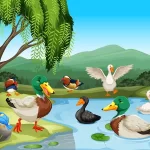CVC words consist of a consonant-vowel-consonant pattern. They play a crucial role in phonics education, aiding children in developing essential reading, writing, and rhyming skills. By focusing on these three-phoneme words, children learn to identify the sounds of individual letters. Also they blend these sounds to form complete words.
The ability to read is foundational to a child’s overall education, impacting their comprehension across various subjects. While some children may like reading intuitively, others may encounter challenges. Making the introduction of simple CVC words can be beneficial to such children. These words allow children to practise reading independently and fosters confidence in them.
Incorporating visual aids, such as pictures associated with CVC words, enhances their learning experience. This method also helps students connect sounds to familiar objects, thereby improving their language skills. Teachers can employ specific strategies to assist students in mastering CVC words effectively.
CVC words – Definition
A CVC word is fundamentally a three-syllable word composed of three phonemes, adhering to the structure of ‘Consonant sound, Vowel sound, Consonant sound,’ which is why it is referred to as CVC.
It is important to note that while many CVC words consist of three letters, not all of them are limited to this length. There are two specific concepts to consider: ‘digraphs,’ which are pairs of letters that produce a single sound, and ‘trigraphs,’ which consist of three letters that also create one sound.
Words like drill, plum, and grass come under digraph and the words like chair, bare, atmosphere are a few examples of trigraph.
Reading Comprehension with CVC Words – Guide
1. Use reveal cards
The concept behind this is to have a CVC word on one side of the card and the corresponding image of the word on the other side of the card.
For instance, if the word is “cat,” one side of the card will show the letters spelling “cat,” while the other side will present a clipped image of a cat. After the student has successfully combined the letters, the image should be revealed to verify their answer. This encourages them to learn new vocabulary and expand their knowledge!
2. Read and match cards
This activity is a variation on the previous concept, but using two different sets of cards instead of clipped images. One set contains cards that spell out common CVC words, while the other set showcases visual representations of those words. Students are tasked with reading the word and matching it to the appropriate image. This method effectively integrates CVC words with corresponding pictures.
This can be adapted into a group exercise or conducted individually by the students. It is advisable to use different colours for the word cards and the image cards to facilitate easy sorting and prevent confusion. This straightforward activity encourages children to engage their analytical skills, aiding in their ability to learn new words more rapidly.
3. Create word-family booklets
CVC words are a fusion of all the vowels: a, e, i, o, and u. By creating a set of vowel families, you can develop engaging activity booklets that allow children to interactively learn these words. Incorporate activities such as circling the CVC words, colouring them, and practising writing, which will captivate childrens’ interest quickly.
This approach is excellent for fostering independent learning. Expanding the experience with various booklets featuring different CVC word families, enables children to continually discover new words and read simple sentences.
4. Hand out simple passages to read
Once students have a solid understanding of CVC words, you can progress to reading simple passages that incorporate these basic words. Each passage should feature CVC words from the same family, making them easier for students to read.
Additionally, the passages can include engaging activities such as colouring a star each time they read the passage, rewriting their favourite sentence, and illustrating the main subject of the text. For instance, if the passage focuses on cats, students can create a drawing of a cat at the end.
5. Use tactical CVC word sets
Students show significant interest when they have the opportunity to construct words by themselves. One effective method is by using tactile CVC sets. To implement this, create image cards featuring CVC words but leave the letter spaces empty.
Provide these cards to your students along with a set of alphabet blocks, allowing them to fill in the blanks with the correct letters to form the corresponding words. This approach has proven to be an effective strategy for enhancing reading comprehension with CVC words.
CVC Words List
Vowel A words
| Bat | Nap |
| Cat | Dad |
| Cab | Sat |
| Rat | Map |
| Gap | Bad |
Vowel E words
| Bed | Wet |
| Fed | Wed |
| Let | Get |
| Pet | Set |
| Met | Beg |
Vowel I words
| Lip | Sit |
| Kit | Fit |
| Pit | Lit |
| Tip | Zip |
| Sip | Rip |
Vowel O Words
| Hot | Rob |
| Fog | Jog |
| Log | Dog |
| Job | Sob |
| Cob | Mop |
Vowel U words
| Hug | Lug |
| But | Cut |
| Rut | Gum |
| Tug | Rub |
| Dug | Jug |
Some Great CVC Word Activities
Here are some really cool CVC word activities that will help take your child’s learning of CVC words to the next level.
Missing Sounds. Write several words on a whiteboard. For each one, leave out a beginning, middle and ending sound. Children have to say what letter is missing, as you sound out each letter.
CVC Playdough. CVC words and Playdough? A great idea indeed! Use that playdough to build the ‘connect’ of given CVC words. A wonderful way of incorporating the sensory skills of children to combine words.
Digital Word Cards. Using these, your children will love building words to match kid-friendly pictures, as they practise CVC words digitally. Moreover, each one can be self-checked as children move the box to reveal the correct answer.
CVC with Magnetic Letters. Use lowercase CVC words to create a perfect Word Workstation. Children will delight in building CVC words, to match cards or pictures.
Needless to say, the curriculum at EuroKids lays a strong emphasis on CVC words being an introduction for the more comprehensive reading skills to follow. We strongly believe that they are a vital tool when introducing many of the phonological awareness skills that young children need to learn.
For informative and accurate articles on all things related to your new born-toddler’s development, growth, health and nutrition, follow EuroKids Blogs and do check out our nationally recognized preschools – EuroKids for the first step in your kid’s educational journey!















